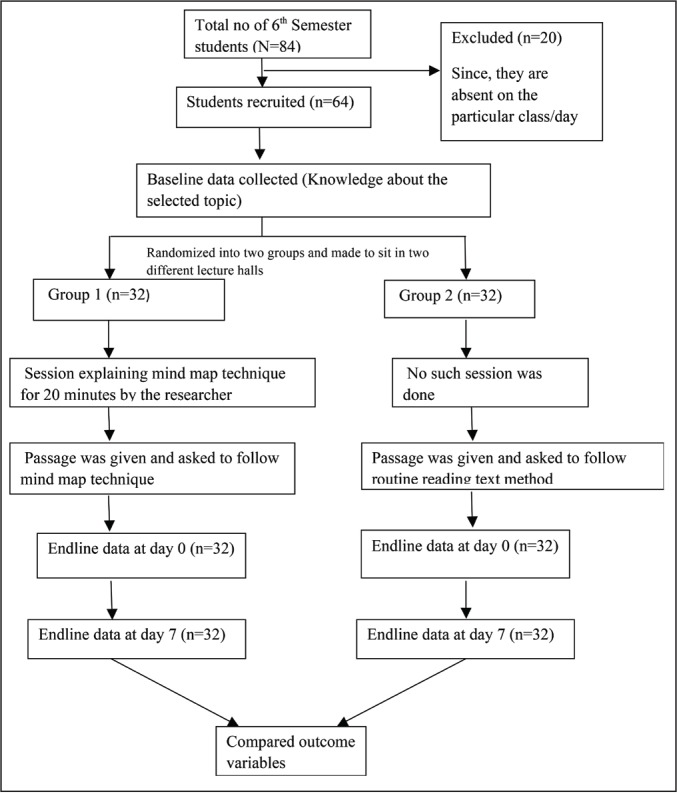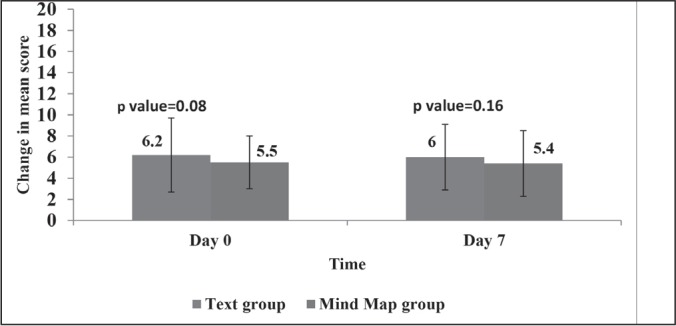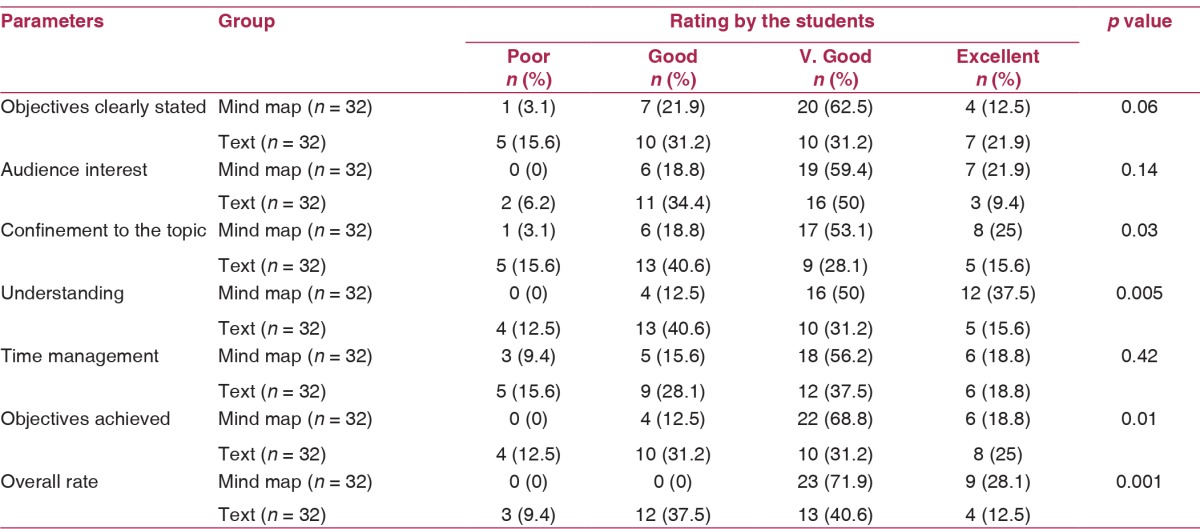Abstract
Background:
The traditional teaching learning methods involve a one way process of transmission of knowledge leaving the students lacking behind in creative abilities. Medical schools need to change their teaching strategies to keep the interest of students and empower them for future self- learning and critical thinking.
Objective:
To assess the impact of mind mapping technique in information retrieval among medical college students in Puducherry.
Methods:
A pilot study was conducted using experimental study design among sixth semester MBBS students (n = 64) at a medical college in Puducherry, India. One group (n = 32) followed the text reading method and another group (n = 32) followed the mind mapping technique to learn the same passage given to them. The knowledge about the topic was assessed using a pre designed questionnaire at baseline, day 0 and day 7. The knowledge gain is the primary outcome variable and is compared between two groups. The feedback regarding the teaching methods was obtained from the participants.
Results:
Mean knowledge score in the text group was lesser than the mind map group at baseline (2.6 Vs 3.5; p = 0.08). On Day 0, the mean score in text group was slightly lesser than the mind map group (8.7 Vs 9.0; p = 0.26). On Day 7, the mean score in mind map group is significantly more than the text group (8.9 Vs 8.5; p = 0.03).
Conclusion:
The mind mapping technique is an innovative and effective method in remembering things better than the routine way of reading texts.
Key words: Information retrieval, medical college, mind map, puducherry, randomized controlled trial
Introduction
Medical education has come a long way over the past few decades. It has evolved greatly from the once blackboard oriented, teacher centered approach to the use of clickers and modern technologies keeping in pace with this digital era. The traditional teaching learning methods like lecture that involve the one way process of knowledge transmission from the teacher to the student leave them lacking behind in creative abilities.[1] In these competitive times, it is essential to transform our medical students from text book muggers and encourage critical thinking. The teaching and learning strategies to support the voluminous amount of course material, which needs to be completed in the four and a half years duration, is minimal.[2]
Medical schools need to change their teaching strategies to keep the interest of students and empower them for future self- learning and critical thinking. Realizing this need, the World Federation for Medical Education came into existence in 1972 with the objective to provide competent medical professionals with the highest scientific and ethical standards.[3] In India, the Medical Council of India (MCI) is now training young medical faculty in modern and innovative teaching technologies.[4]
Newer techniques that keep up with the growing times are necessary in medical education as well. One such method is the ‘Mind Mapping technique’. This technique, first developed by Tony Buzan, is a map with a “central image, main themes radiating from the central image, branches with key images and key words, plus branches forming a connected nodal structure”.[5] It enables the learner to draw the information in diagrams instead of writing it in sentences, makes it possible to concise vast amount of information on a single page, thus making it easy for the students to refresh the information just by a glance.[6] This technique, which makes complex text simpler and improves self- learning is gaining attention. The use of attractive colours, pictures and flowcharts capture the interest of audience making it pleasing to the eyes of the reader, bringing about a renewed sense of enthusiasm in the classroom.[2,7] Data also suggests that mind mapping helps improve the ability to remember and recall facts better.[8]
Therefore, we have undertaken the present study to assess the effectiveness of mind mapping technique in improving the ‘memory’ component of the cognitive domain of learning of the medical college students.
Methods
We conducted a pilot study using experimental design among sixth semester MBBS students (n = 64) at Pondicherry Institute of Medical Sciences, Pondicherry during May 2014. All the sixth semester MBBS students who attended the community medicine class (2 hour) on 10th May 2014 were included in the study, and those who were absent on that day were excluded [Figure 1]. Informed consent was obtained from all the participant students. A topic from the recommended text book of Community Medicine was randomly selected, and the topic was unknown to the participants till the initiation of the study, that is, distribution of the passage regarding selected topic to be learnt. The baseline knowledge about the topic was assessed using predesigned questionnaire among all the participants. The questionnaire had ten Multiple Choice Questions (MCQs) from the selected topics designed by the researchers and their team. Face validity and content validity was done. Each right response carried 1 point and wrong response carried 0 point. Thus, knowledge of the participants was measured as scale (numerical) variable and mean scores were calculated.
Figure 1.

Trial Profile:
The participants were then randomized into two groups using simple randomization (lottery method) technique. Each group was made to sit in a separate lecture hall. Blinding was not done as the intervention is training based.
One group (n = 32) received the three sided text passage (approximately 1500 words) of the selected topic from a standard text book and were asked to read the topic by routine text reading method, and for the other group (n = 32), the researcher had a special session for 20 minutes to teach them about the learning method through mind map technique, and they were asked to follow the mind map technique to learn the same passage received by the other group. Time allotted for each group to learn the topic, through the respective methods advised to them, was 20 minutes.
The knowledge of the participants was assessed on Day 0 (immediately after intervention) and at Day 7 after the intervention. The knowledge gain is the primary outcome variable and it is compared between the two groups. The feedback regarding the teaching methods was obtained from the participants.
The data was entered and analyzed in SPSS version 16.0 by a post graduate student who was not involved in the study (blinded to the intervention). The difference in the mean knowledge score between the groups before intervention, immediately after intervention (day 0) and one week (day 7) after the intervention, was calculated. The difference in the knowledge gain between the groups immediately after intervention and one week after the intervention was also calculated. Student t test was used to test the hypothesis. The feedback regarding the teaching methods was graded in likert scale by the participants under various parameters. The proportions were calculated and compared between the groups; chi-square test was used to see the significant difference of proportions between the groups. The content analysis of the responses / comments and suggestions given for the open ended questions of feedback form was also done.
Sample size was not calculated initially. However, power analysis done retrospectively showed that the achieved sample size (n = 32 in each group) is able to detect the mean difference of 0.4 between the group 1 (SD1 = 0.46) and group 2 (SD2 = 0.97) with 90% CI and 69% power.
Results
A total of 64 participants were recruited and randomized into two groups of 32 each. [Table 1] shows that in both the groups, there were 46.9 % (n = 15) males and 53.1% (n = 17) females, and there was no significant difference between the mean marks obtained in the recent internal test in the subject of community medicine (p = 0.199).
Table 1.
Comparison of gender distribution and mean marks in the recent internal exam between both the groups.

It was found that at baseline (before intervention), the mean knowledge score in the text group is 2.6, which is slightly lesser than the mean score of the mind map group (3.5). But, the difference is not statistically significant (p = 0.08). At Day 0 (i.e.,) immediately after intervention, the mean score in the text group increased to 8.7, whereas in the mind map group, it increased to 9.0. The difference is not statistically significant (p = 0.26). At Day 7 (i.e.,) one week after intervention, the mean score in the mind map group is significantly more than the text group (8.9 Vs 8.5; p = 0.03) [Figure 2].
Figure 2.

Comparison of the mean score of the participants across the timeline between both the groups (n = 32 each)
The knowledge gain at day 0 is measured by the change in mean score between baseline and at day 0, [Figure 3] it is found to be 6.2 in text group and 5.5 in mind map group, and the difference is statistically insignificant (p = 0.08). Similarly, we could not observe the significant difference in knowledge gain at day 7 (i.e.,) change in mean score between baseline and at day 7 is 6 and 5.4 in the text group and the mind map group, respectively (p = 0.16). The mean difference between the difference of mean score between the groups at Day 0 and Day 7 is -0.68 (95% CI: -1.46, 0.08), and the mean difference between the difference of mean score between baseline and day 7 is 0.57 (95% CI: 1.3, 0.22), which is not statistically significant.
Figure 3.

Comparison of the knowledge gain at day 0 and at day 7 after intervention between the groups (n = 32 each)
[Table 2] shows the comparison of the rating of the two teaching methods given by the students on various parameters. In parameters like confined to the topic, easy understanding of the topic, objectives achieved, significantly higher proportions of students have given the very good and/or excellent rating to mind map method, when compared to the text method of learning.
Table 2.
Comparison of the rating of the teaching methods given by the participants under various parameters.

The students have given their view regarding strengths and weaknesses of their respective teaching methods. They also gave valuable comments in their feedback [Table 3].
Table 3.
Content analysis of the comments and suggestion given by the participants

Discussion
A RCT was done among 64 sixth semester medical students in a medical college at Puducherry to find the effectiveness of mind mapping learning strategy in information retrieval (knowledge gain) among them.
The limitations of our study is that we had studied among a small convenient sample of sixth semester medical students, which may not be the representative of all medical students and the power of the study is 69% only. Thus, the results should be interpreted and extrapolated cautiously.
There was no significant difference in the gender distribution and the mean marks obtained in the recent internal test in community medicine between the groups, suggesting that the randomization was effective and the groups were comparable. At baseline, the difference in mean knowledge score regarding the selected topic among the two groups is not significant. This shows that the both groups had same knowledge regarding the topic before the intervention.
Although, the mean score immediately after intervention is slightly higher in the mind map group than the text group, the difference is statistically not significant. This gives us the picture that the mind map technique might not be superior to the routine learning strategy in short term information retrieval. The similar results were observed in various other studies as well.[2] However, with only brief overview about the technique without a practice period to increase proficiency in creating mind maps, this group had scored higher than the other group, who had the benefit of following the used method that has been firmly reinforced throughout their academic careers. It is an encouraging point for the novice technique to be incorporated as one of the strategy in medical teaching. Moreover, when the knowledge of the participants was again assessed after a week to check the amount of information retention using the same questionnaire, used for baseline assessment and at Day 0 assessment, it was found that the mean score of the mind map group is significantly higher than the text group. This shows that the mind mapping technique helps significantly in the retention of information for long time, which concurs with the findings of the study done by Farrand P et al.[8]
According to Blooms taxonomy, the order of thinking skills in increasing order (lower to higher) is: remembering, understanding, applying, analyzing, evaluating, and creating.[9] Our study examined the remembering (Lower order thinking skills) part only. There is a need of further studies to check impact of the mind map strategy on higher order thinking skills like creative thinking.
The traditional method of reading text/ books is described as a boring activity by the students, and this can be turned to be a more enjoyable activity by using some innovative techniques. The mind map technique is one such innovative technique, which has created interest among the students. This was clearly visible in the rating and comments given by the students for this technique. One of the student described “Can reciprocate mind map in all topics and in all subjects”, and some students expressed that learning by mind map made them to understand the concept and made them attentive throughout the class. Many students felt that this is relief from the routine PowerPoint based lecture. There were some responses from the students that this method stimulated lateral thinking among them.
Thus, the need of the hour in medical teaching is to shift from the teacher centred conventional methods to student centred innovative methods, because the purpose of education is not just making a student literate, but adds rationale thinking, knowledgeablity, and self- sufficiency. The mind mapping technique is one such innovative technique, which was found to be useful in remembering things better than the routine way of reading texts and this strategy was found attractive by the learners too. The long term use of this method has not been studied yet. Therefore this strategy needs to be investigated longitudinally to see its long term effects and the impact among the higher order skills such as creative thinking, as suggested by Daley and Torre in their recent analytical review.[10] The author also recommends that further studies are required to find the impact of this novice technique in medical teaching with more representative sample and with an adequate number of participants.
Financial support and sponsorship
Nil.
Conflicts of interest
There are no conflicts of interest.
References
- 1.Zhao Y. The use of a constructivist teaching model in environmental science at Beijing Normal University. The China Papers. 2003:78–83. [Google Scholar]
- 2.D'Antoni AV, Zipp GP, Olson VG, Cahill TF. Does the mind map learning strategy facilitate information retrieval and critical thinking in medical students? BMC Medical Education. 2010;10:61. doi: 10.1186/1472-6920-10-61. [DOI] [PMC free article] [PubMed] [Google Scholar]
- 3.World Federation for Medical Education: foundation and constitution. [Last accessed on 2015 Jan 17]. Available from: http://wfme.org/about/wfmeconstitution .
- 4.Singh S. Senior Resident Training on Educational Principles (STEP): A Proposed Innovative Step from a Developing Nation. Journal of Educational Evaluation for Health Professions. 2010;7:3. doi: 10.3352/jeehp.2010.7.3. [DOI] [PMC free article] [PubMed] [Google Scholar]
- 5.Tee T. K, MNAA Mohamed S, Muhammad M, Mohamad M.M, Md Yunos J, Buzan Mind Mapping: An Efficient Technique for Note-Taking International Journal of Social. Human Science and Engineering. 2014;8:28–31. [Google Scholar]
- 6.Sachou M-E. Innovative Methods of Teaching, 2013. International Conference The Future of Education. 3rd ed. [Last accessed on 2015 Feb 23]. Available from: http://conference.pixel-online.net/foe2013/common/download/Paper_pdf/083-ITL13-FP-Sachou-FOE2013.pdf .
- 7.Bang Khan hNongTAP, Thy Nu Mai Tran. Integrate the Digital Mind mapping into Teaching and Learning Psychology [Google Scholar]
- 8.Farrand P, Hussain F, Hennessy E. The efficacy of the ‘mind map’ study technique. Medical Education. 2002;36:426–31. doi: 10.1046/j.1365-2923.2002.01205.x. [DOI] [PubMed] [Google Scholar]
- 9.Phillips AW, Smith SG, Straus CM. Driving deeper learning by assessment: an adaptation of the Revised Bloom's Taxonomy for medical imaging in gross anatomy. Academic Radiology. 2013;20:784–9. doi: 10.1016/j.acra.2013.02.001. [DOI] [PubMed] [Google Scholar]
- 10.Daley BJ, Torre DM. Concept maps in medical education: an analytical literature review. Medical Education. 2010;44:440–8. doi: 10.1111/j.1365-2923.2010.03628.x. [DOI] [PubMed] [Google Scholar]


